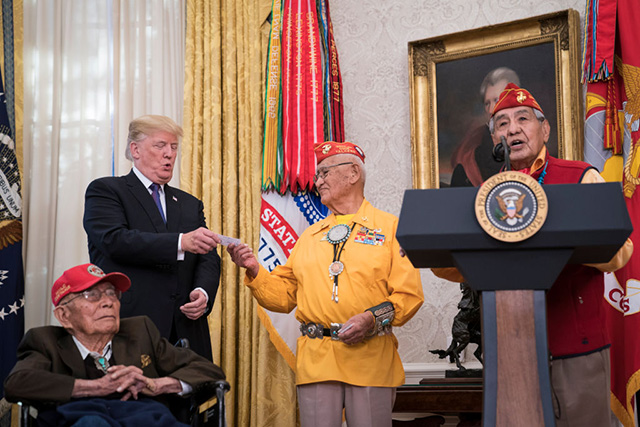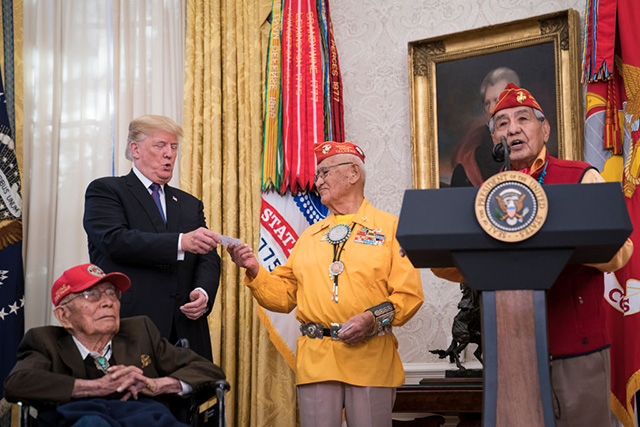
 Donald Trump at a meeting with Navajo Code Talkers, including Fleming Begaye Sr. (seated), Thomas Begay (center) and Peter MacDonald in the Oval Office on November 27, 2017. (Photo: Jabin Botsford / The Washington Post via Getty Images)
Donald Trump at a meeting with Navajo Code Talkers, including Fleming Begaye Sr. (seated), Thomas Begay (center) and Peter MacDonald in the Oval Office on November 27, 2017. (Photo: Jabin Botsford / The Washington Post via Getty Images)Acting by fiat and claiming the opposite has been a hallmark of this presidency.
On Monday in Salt Lake City, President Trump announced he was reducing the Bears Ears National Monument by 85 percent, from 1.3 million acres to 201,876 acres — despite it being unclear whether he has the legal right to do so under the Antiquities Act.
“Your timeless bond with the outdoors should not be replaced with the whims of regulators thousands and thousands of miles away,” he assured supporters inside the state Capitol as hundreds protested outside (an estimated 5,000 had protested the expected reduction of Bears Ears and Grand Escalante National Monuments at the Capitol the day before).
And yet, strangely, fellow heads of state from five indigenous nations (Navajo Nation, Hopi, Zuni, Ute Mountain Ute, and Uintah and Ouray Ute) which have a “timeless bond” with the area in question and who wrote the national monument proposal for Bears Ears were nowhere to be seen in the Capitol. Instead, tribal leaders could be found outside protesting. These included the vice president of the Navajo Nation — an indigenous nation the size of Ireland — which has 350,000 members.
“The Navajo Nation has made repeated requests to meet with President Trump on this issue. The Bears Ears Monument is of critical importance, not only to the Navajo Nation, but to many tribes in the region,” Navajo Nation President Russell Begaye said in a statement to the press. “The decision to reduce the size of the monument is being made with no tribal consultation.”
Instead, Secretary Ryan Zinke brought onstage to stand behind Trump a diminutive and traditionally dressed Navajo grandmother, Betty Jones of McCracken Mesa in San Juan County, Utah. Zinke, who’s over 6 feet tall, held her by her shoulders, and Trump turned to engage her awkwardly from time to time.
This is the second time in as many weeks that Trump has used Navajo elders as what can only be called political props. Last week he caused a furor during a ceremony honoring Navajo Code Talkers from WWII, men in their 90s, when he took a potshot at potential presidential contender Sen. Elizabeth Warren, calling her “Pocahontas.”
The Bears Ears National Monument signed into law in December 2016 by former President Obama was heralded as an advance in nation-to-nation relations between the US government and indigenous nations. The monument proclamation not only recognizes these tribes’ inherent national interests and ancient connections to the Bears Ears area, but gives them a seat at the table to co-manage the monument, which contains an estimated 100,000 archaeological sites.
Tribal leaders chose to pursue national monument status for Bears Ears in 2015 when discussions with Utah Republican politicians, including Rep. Rob Bishop (who stood beside Trump when he made his announcement), broke down. Looting and vandalism of ancient petroglyphs and stunning cliff dwellings have been ongoing in the area, even since the monument’s designation last year.
San Juan County, which is one of the largest counties in the country, has a history of suppressing the Navajo vote. The county, which has a population that is over 50 percent Navajo, was sued by the Navajo Nation Human Rights Commission and in 2016 was found in violation of the Voting Rights Act by racially segregating Navajo voters into a single district.
Before Trump spoke on Monday, San Juan County Commissioner Rebecca Benally spoke, claiming the creation of the Bears Ears National Monument “was disheartening for my community.” But while Benally is a Navajo woman, she’s not a tribal leader, and San Juan County’s stance opposing the monument is not shared by the Navajo Nation.
Navajo Nation Attorney General Ethel Branch pointed out that consulting with one Navajo person is not the same as consulting with the nation. “He’s ignoring the fact that we are sovereigns, we are governments, and expect to be engaged on a nation-to-nation basis,” said Branch in an interview with MSNBC. “If they think talking to one Navajo person constitutes talking to the Navajo Nation, then [Zinke and Trump] are both gravely mistaken.”
In fact, it’s been reported that in the past few months 98 percent of Navajo community members bordering Bears Ears have voted in favor of the monument designation at chapter house meetings (similar to counties on the Navajo Nation).
Echoing Trump, Benally added, “It was insulting that bureaucrats thousands of miles away didn’t believe we were capable of protecting our land.”
In contrast, Begaye seemed confident that his nation was doing just that.
“The Navajo Nation will defend Bears Ears. The reduction in the size of the monument leaves us no choice but to litigate this decision.”
Join us in defending the truth before it’s too late
The future of independent journalism is uncertain, and the consequences of losing it are too grave to ignore. To ensure Truthout remains safe, strong, and free, we need to raise $27,000 in the next 24 hours. Every dollar raised goes directly toward the costs of producing news you can trust.
Please give what you can — because by supporting us with a tax-deductible donation, you’re not just preserving a source of news, you’re helping to safeguard what’s left of our democracy.